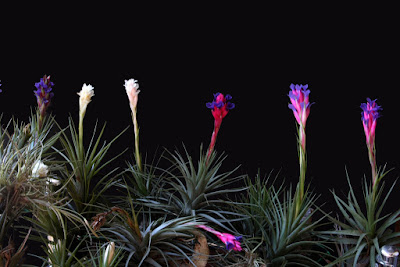Tillandsia aeranthos is native to southern Brazil, Paraguay, Uruguay, and Argentina. It is found growing on trees and rocks, from sea level to 300m in areas bordering rivers.
Tillandsia aeranthos, also called as Pourretia aeranthos, Anoplophytum aeranthos, Tillandsia dianthoidea, Tillandsia bicolor, Anoplophytum dianthoideum, Anoplophytum roseum, Tillandsia unca, Tillandsia microxiphion, is a species of the genus Tillandsia. This species was described by Lyman Bradford Smith in 1943.
IDENTIFY TILLANDSIA AERANTHOS AIR PLANT
Tillandsia aeranthos is native to southern Brazil, Paraguay, Uruguay, and Argentina. It is found growing on trees and rocks, from sea level to 300m in areas bordering rivers.
It is a small herb, from 15 to 20 cm high, epiphytic, with a strong rhizome covered with the old remains of the sheaths, with strong roots, suberect, a little recurved, densely covered with adpressed scales, suborbicular, not tomentose, on both sides, silver-green leaves that form a rosette.
This air plant flowering in July to December and January from the simple, compact, sub-lax after anthesis, 10-15 flowers polystichously, subsessiles, sub-erect inflorescence. The floral bracts re suberect, elliptic, mucronate, inflated, membrenaceous, scaled, the basal ones exceeding the flowers, the top ones of the same size or shorter, strong rose or red. The flowers are violet, sessile, erect or suberect. Sepals lanceolate, acute, 12-19 mm long, the posterior high-connate, membrenaceous, glabrous; Petals 17-27 mm long, the blades broadly elliptic, very dark blue.
The flowers may be confused by neophytes with those of Tillandsia bergeri but are distinguished by wider (overlapping) petals, a little shorter, darker, more erect and without white lines in the center. As a result, the flowers are narrower than in Tillandsia bergeri (because the petals are slightly shorter and more erect, as if the flower did not open completely).
TILLANDSIA AERANTHOS AIR PLANT CARE AND CULTURE
Cultural information should only be used as a guide, and should be to be adapted to suit you. Your physical location; where you grow your plants, how much time you have to devote to their care, and many other factors, will need to be taken into account. Only then can you decide on the cultural methods that best suit you and your plants.
Light:
Tillandsia aeranthos grows best in full sun to partial sun. In the hottest climates, it is best given some afternoon shade. In a dark location the plant will gradually weaken and wither. In winter, you should find a luminous place. This species is grown outdoors in summer in sunny conditions (see below). Place it very close to a window indoors in the winter, the brightness must remain maximum throughout the year.
Temperature:
It is very resistant, this species can withstand high temperatures and frost for short periods if the plant is large enough (-5 ° C for short periods if it is dry). It is one of the rare species of Tillandsia able to stay out in winter. It appreciates the cool at night (10 to 12 ° C approximately), even the summer. However they grow best in a spot with plenty of light, with summertime temperatures of 20-30 ° C or higher and winter temperatures around 15 ° C.
Humidity:
This species need the humidity level of moderate to low. The plant tolerates drought periods well. Good aeration is required, the plant must dry quickly (in less than an hour).
Substrate, growing media and repotting:
Tillandsia aeranthos refer to be mounted on a solid substrate that does not retain water. You can glue the plant directly to the surface with a strong adhesive, or you can wire the plant to the base. Don't cover the base of the plant with moss or it may rot. It can be grown on almost any imaginable decorative mount, including shells, rocks, slate, driftwood, etc. Group them in decorative clumps for maximum effect.
Watering:
Twice a week in summer, once every 10 days in winter according to the luminosity and the ambient humidity. Obviously when it rains and if you grow it outside, it counts as a watering.
Fertilizer:
This air plant can be fertilized with the moderate doses. 1 to 2 times a month in the summer and 1 time a month in the winter.















COMMENTS